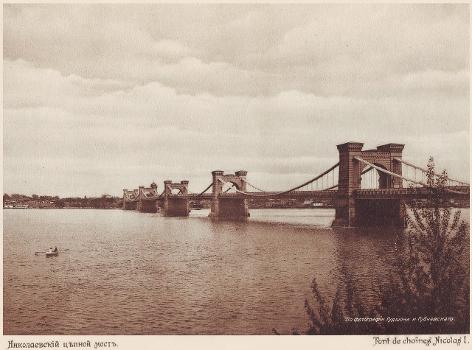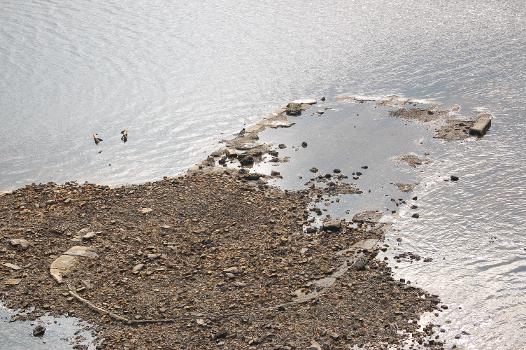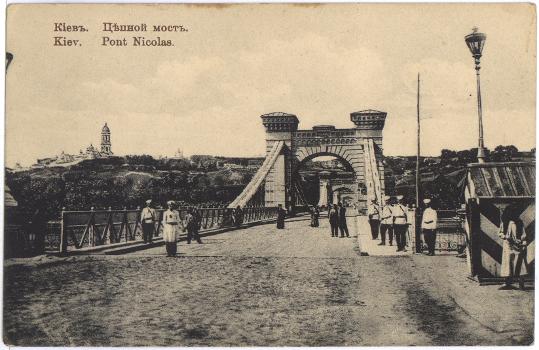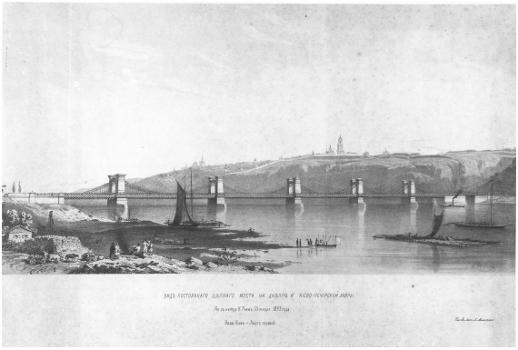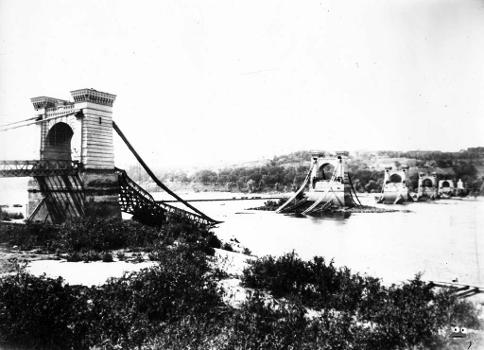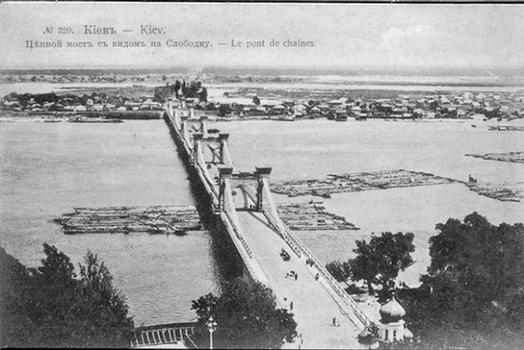General Information
| Other name(s): | Tsar Nicholas I Suspension Bridge |
|---|---|
| Beginning of works: | 30 August 1848 |
| Completion: | 28 September 1853 |
| Status: | demolished (10 June 1920) |
Project Type
| Structure: |
Chain suspension bridge |
|---|---|
| Function / usage: |
Road bridge |
| Material: |
Iron bridge |
| Structure: |
Multi-span suspension bridge |
| Plan view: |
Structurae Plus/Pro - Subscribe Now! |
| Material: |
Structurae Plus/Pro - Subscribe Now! Structurae Plus/Pro - Subscribe Now! |
Location
Technical Information
Dimensions
| total length | 780.90 m | |
| span lengths | 68.58 m - 4 x 134.1 m - 68.58 m - 15.24 m | |
| clearance | ø 9.14 m | |
| number of spans | 7 | |
| chains | number of chains | 4 |
| deck | width | 16.00 m |
| suspended length | 637.03 m | |
| pylons | pylon height (total) | 34.14 m |
Cost
| cost of construction | ca. Pound sterling 432 000 |
Materials
| deck |
iron
|
|---|---|
| piers |
stone
|
| foundations |
concrete
|
| chains |
iron
|
| towers |
stone
|
Chronology
| November 1846 | Invitation to tender. |
|---|---|
|
12 December 1846
— March 1847 |
Charles Blacker Vignoles prepares his preliminary proposal and takes it to Saint Petersburg. The proposal is accepted by the Tsar. |
|
March 1847
— June 1847 |
Working drawings are produced. |
|
July 1847
— August 1847 |
Two-day site visit to Kiev followed by negotiations in Saint Petersburg to agree on the final design. |
| September 1847 | Contract is signed. |
|
October 1847
— March 1848 |
The necessary materials are procured. The iron work and machinery comes from the UK, granite and wood from Russia. |
| March 1848 | Design check is carried out. |
|
April 1848
— October 1848 |
Preparations on-site begin: working areas and construction camps are installed. An inclined plane is created, a temporary bridge and railway is built. Cofferdams are built and a cement plant is set up. |
| 9 September 1848 | First stone is laid. |
| November 1848 | Works are damaged by ice floes. The site is closed down for winter. |
|
March 1849
— April 1849 |
Ice floes damage the temporary bridge. |
| May 1849 | The cofferdams are over-topped by spring floods. Dams 2 and 3 rise by 7 feet, dam 4 breaks up, dam 5 is scoured down by 10 to 15 feet. Some stone-filled barges are sunk on the remaining dams to hold them down. |
|
May 1849
— September 1849 |
The cofferdams are rebuilt. 3 rings of piles are used instead of 2 and the timber length is increased to 56 feet. |
| September 1849 | Concrete bases are completed for the pier and abutment foundations on the supports nearest to the shores (2 on the south, 1 on the right bank). |
| October 1849 | Fascine mattresses are installed around the dams to protect the from scour. |
| November 1849 | The site is closed down for winter. |
|
May 1850
— November 1850 |
Concreting of foundations proceeds vers slowly. Pumps break down and dams leak. Foundations for the two northernmost suspension towers are completed. |
|
May 1851
— November 1851 |
The roadway on the swing bridge is completed. The remaining three tower foundations are finished and their piers built up above flood level. The portals on the two northernmost towers are completed and the ropes are hung. |
| February 1852 | The raising of the chains continues throught the winter. |
| May 1852 | The portals are completed. |
| August 1852 | The raising of the chains begins, but only one is completed by September. |
| April 1853 | Chains are completed. |
| August 1853 | The deck is completed. |
| 30 September 1853 | Test loading of the bridge. A test load of 3000 tons of wet sand is used. |
| 10 October 1853 | Opening. |
Excerpt from Wikipedia
The Nicholas Chain Bridge (or Nikolaevsky Chain Bridge; Ukrainian: Миколаївський ланцюговий міст; Russian: Николаевский цепной мост) was a chain bridge over the Dnieper that existed from 1855 to 1920 in Kyiv.
Overview
The bridge was designed by British engineer Charles Blacker Vignoles. Construction started in 1848 and was completed in 1853. The 776-metre-long (2,546 ft) bridge was the largest at that time in Europe. A silver model of the bridge was presented at The Great Exhibition in London.
In 1920, during the Polish-Soviet War, the bridge was blown up by retreating Polish troops. It was restored based on old drawings by Evgeny Paton and opened again in 1925 under the name Yevgenia Bosch Bridge. Paton had significantly changed its structure and raised it by several metres, so that the Yevgenia Bosch Bridge may be considered as a new bridge.
On 19 September 1941, Yevgenia Bosch Bridge was demolished by retreating Soviet troops and was never restored after the war. In 1965 in place of the former chain bridge a new Kyiv Metro Bridge was built.
Text imported from Wikipedia article "Nicholas Chain Bridge" and modified on March 19, 2022 according to the CC-BY-SA 4.0 International license.
Participants
Relevant Web Sites
Relevant Publications
- (1999): Bridge Engineering Handbook. CRC Press, Boca Raton (USA), pp. 66-2.
- (2013): Bridge Engineering in Ukraine. In: (2013): Handbook of International Bridge Engineering. CRC Press, Boca Raton (USA), ISBN 978-1439810293, pp. 868-869.
- (2012): The construction of the Kiev Suspension Bridge 1846–1853. In: Proceedings of the Institution of Civil Engineers - Engineering History and Heritage, v. 165, n. 1 (February 2012), pp. 21-45.
- (2006): Kiev Suspension Bridge 1846 - 1853. Presented at: Second International Congress on Construction History, Queens' College, Cambridge University; 29/03-02/04/2006, pp. 3211-3231.
- About this
data sheet - Structure-ID
20005655 - Published on:
30/09/2002 - Last updated on:
19/03/2022

